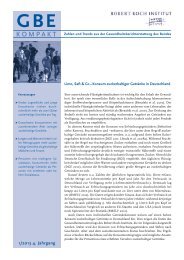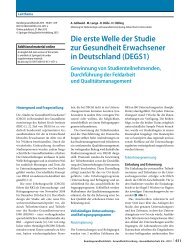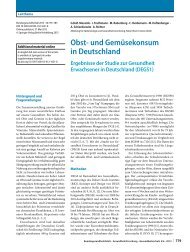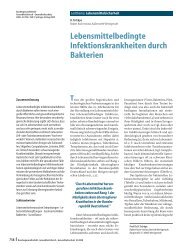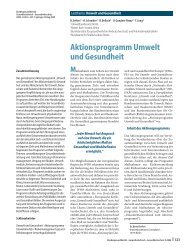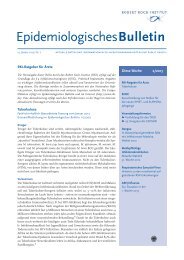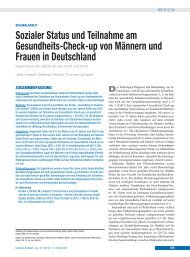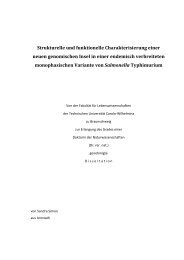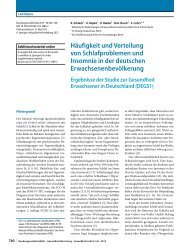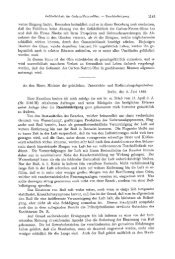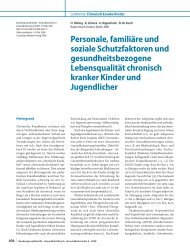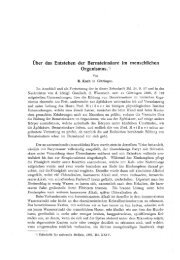HERV-K - RKI
HERV-K - RKI
HERV-K - RKI
Create successful ePaper yourself
Turn your PDF publications into a flip-book with our unique Google optimized e-Paper software.
Properties of the Transmembrane Protein of <strong>HERV</strong>-K<br />
specific for the His-tag. c, Western blot analysis using a goat serum<br />
specific for the TM protein produced in E. coli. M -– marker<br />
proteins, 1– TM protein produced in yeast cells and purified by<br />
His-tag affinity chromatography. 2– bovine serum albumin, 3 -<br />
TM protein produced as calmodulin binding fusion protein in E.<br />
coli. d, Amino acid sequence of the entire TM protein of <strong>HERV</strong>-K<br />
and the epitopes recognised by the goat serum after immunisation<br />
with the TM protein produced in E. coli. Blue – sequence of the<br />
ectodomain of the TM protein used for immunisation, red – Asn-<br />
Xaa-Ser/Thr sequences, green – immunosuppressive domain,<br />
underlined – potential glycosylation site according the NetNGlyc<br />
1.0 program, brown – Cys – Cys loop.<br />
(TIF)<br />
Table S1 Examples of the sequences of the isu domain<br />
of different <strong>HERV</strong>-K proviruses. Mutations are marked in<br />
red.<br />
(DOCX)<br />
Table S2 Abbreviations and full names of the cytokines<br />
tested for (see Fig. 4). Cytokines with increased expression are<br />
shown in red.<br />
References<br />
1. Löwer R, Löwer J, Kurth R (1996) The viruses in all of us: characteristics and<br />
biological significance of human endogenous retrovirus sequences. Proc Natl<br />
Acad Sci 93: 5177–5184.<br />
2. Ruprecht K, Mayer J, Sauter M, Roemer K, Mueller-Lantzsch N, et al. (2008)<br />
Endogenous retroviruses and cancer. Cell Mol Life Sci 65: 3366–3382.<br />
3. Denner J (2010) Endogenous retroviruses. In: Kurth R, Bannert N, editors.<br />
Retroviruses: Molecular biology, genomics and pathogenesis. Hethersett: Caister<br />
Academic Press, 35–69.<br />
4. Löwer R, Boller K, Hasenmaier B, Korbmacher C, Müller-Lantzsch N, et al.<br />
(1993) Identification of human endogenous retroviruses with complex mRNA<br />
expression and particle formation. Proc Nat Acad Sci 90: 4480–4484.<br />
5. Turner G, Barbulescu M, Su M, Jensen-Seaman MI, Kidd KK, et al. (2001)<br />
Insertional polymorphisms of full-length endogenous retroviruses in humans.<br />
Curr Biol 11: 1531–1535.<br />
6. Boller K, König H, Sauter M, Mueller-Lantzsch N, Löwer R, et al. (1993)<br />
Evidence that <strong>HERV</strong>-K ist the endogenous retrovirus sequence that codes for<br />
the human teratocarcinoma-derived retrovirus HDTV. Virology 196: 349–353.<br />
7. Löwer J, Löwer R, Stegmann J, Frank H, Kurth R, et al. (1981) Retrovirus<br />
particle production in three of four human teratocarcinoma cell lines. Haematol<br />
Blood Transfus 26: 541–544.<br />
8. Sauter M, Schommer S, Kremmer E, Remberger K, Dölken G, et al. (1995)<br />
Human endogenous retrovirus K10:expression of Gag protein and detection of<br />
antibodies in patients with seminomas. J Virol 69: 414–421.<br />
9. Muster T, Waltenberger A, Grassauer A, Hirschl S, Caucig P, et al. (2003) An<br />
endogenous retrovirus derived from human melanoma cells. Cancer Res 63:<br />
8735–8741.<br />
10. Büscher K, Trefzer U, Hofmann M, Sterry W, Kurth R, et al. (2005) Expression<br />
of human endogenous retrovirus K in melanomas and melanoma cell lines.<br />
Cancer Res 65: 4172–4180.<br />
11. Büscher K, Hahn S, Hofmann M, Trefzer U, Ozel M, et al. (2006) Expression of<br />
the human endogenous retrovirus-K transmembrane evelope, Rec and Np9<br />
proteins in melanomas and melanoma cell lines. Melanoma Res 16: 223–234.<br />
12. Kämmerer U, Germeyer A, Stengel S, Kapp M, Denner J (2011) Human<br />
endogenous retrovirus K (<strong>HERV</strong>-K) is expressed in villous and extravillous<br />
cytotrophoblast cells of the human placenta. J Reprod Immunol 91: 1–8.<br />
13. Blond JL, Beseme F, Duret L, Bouton O, Bedin F, et al. (1999) Molecular<br />
characterization and placental expression of <strong>HERV</strong>-W, a new human<br />
endogenous retrovirus family. J Virol 73: 1175–1185.<br />
14. Blond JL, Lavillette D, Cheynet V, Bouton O, Oriol G, et al. (2000) An envelope<br />
glycoprotein of the human endogenous retrovirus <strong>HERV</strong>-W is expressed in the<br />
human placenta and fuses cells expressing the type D mammalian retrovirus<br />
receptor. J Virol 74: 3321–29.<br />
15. Mi S, Lee X, Li X, Veldman GM, Finnerty H, et al. (2000) Syncytin is a captive<br />
retroviral envelope protein involved in human placental morphogenesis. 403:<br />
785–789.<br />
16. Malassine IA, Blaise S, Handschuh K, et al. (2007) Expression of the fusogenic<br />
<strong>HERV</strong>-FRD Env glycoprotein (syncytin 2) in human placenta is restricted to<br />
villous cytotrophoblastic cells. Placenta 28: 185–191.<br />
17. Malassine A, Frendo JL, Blaise S, Handschuh K, Gerbaud P, et al. (2008)<br />
Human endogenous retrovirus-FRD envelope protein (syncytin 2) expression in<br />
normal and trisomy 21-affected placenta. Retrovirology 5: 6.<br />
18. Dupressoir A, Marceau G, Vernochet C, Bénit L, Kanellopoulos C, et al. (2005)<br />
Syncytin-A and syncytin-B, two fusogenic placenta-specific murine envelope<br />
(DOCX)<br />
Table S3 Results of the microarray analysis: Upregulated<br />
genes.<br />
(DOCX)<br />
Table S4 Results of the microarray analysis: Downregulated<br />
genes.<br />
(DOCX)<br />
Acknowledgments<br />
We would like to thank Martina Keller, Rayk Behrendt and Karin<br />
Braunmüller for excellent technical support.<br />
Author Contributions<br />
Conceived and designed the experiments: JD. Performed the experiments:<br />
VAM VLDT JD. Analyzed the data: VAM VLDT JD. Wrote the paper:<br />
VAM JD VLDT.<br />
genes of retroviral origin conserved in Muridae. Proc Natl Acad Sci 102: 725–<br />
730.<br />
19. Dupressoir A, Vernochet C, Harper F, Guégan J, Dessen P, et al. (2011) A pair<br />
of co-opted retroviral envelope syncytin genes is required for formation of the<br />
two-layered murine placental syncytiotrophoblast. Proc Natl Acad Sci 108:<br />
E1164–1173.<br />
20. Heidmann O, Vernochet C, Dupressoir A, Heidmann T, et al. (2009)<br />
Identification of an endogenous retroviral envelope gene with fusogenic activity<br />
and placenta-specific expression in the rabbit: a new ‘‘syncytin’’ in a third order<br />
of mammals. Retrovirology 6: 107.<br />
21. Vernochet C, Heidmann O, Dupressoir A, Cornelis G, Dessen P, et al. (2011) A<br />
syncytin-like endogenous retrovirus envelope gene of the guinea pig specifically<br />
expressed in the placenta junctional zone and conserved in Caviomorpha.<br />
Placenta 32: 885–892.<br />
22. Cornelis G, Heidmann O, Bernard-Stoecklin S, Reynaud K, Véron G, et al.<br />
(2012) Ancestral capture of syncytin-Car1, a fusogenic endogenous retroviral<br />
envelope gene involved in placentation and conserved in Carnivora. Proc Natl<br />
Acad Sci 109: 432–441.<br />
23. Arnaud F, Varela M, Spencer TE, Palmarini M. et al. (2008) Coevolution of<br />
endogenous betaretroviruses of sheep and their host. Cell Mol Life Sci 65: 3422–<br />
3432.<br />
24. Mangeney M, Heidmann T (1998) Tumor cells expressing a retroviral envelope<br />
escape immune rejection in vivo. Proc Natl Acad Sci 95: 14920–14925.<br />
25. Denner J (1998) Immunosuppression by retroviruses: implications for xenotransplantation.<br />
Ann NY Acad Sci 862: 75–86.<br />
26. Oostendorp RA, Meijer CJ, Scheper RJ (1993) Immunosuppression by<br />
retroviral-envelope-related proteins, and their role in non-retroviral human<br />
disease. Crit Rev Oncol Hematol 14: 189–206.<br />
27. Morozov VA, Morozov AV, Semaan M, Denner J (2012) Single mutations in<br />
the transmembrane envelope protein abrogate the immunosuppressive property<br />
of HIV-1. Retrovirology 9(1): 67.<br />
28. Denner J, Eschricht M, Lauck M, Semaan M, Schlaermann P, et al. (2013)<br />
Modulation of cytokine release and gene expression by the immunosuppressive<br />
domain of gp41 of HIV-1. PLOS ONE, 8(1).<br />
29. Woessner F, Nagase H, eds. (2000) Matrix metalloproteinases and TIMPs, New<br />
York: Oxford University Press.<br />
30. Bleharski JR, Kiessler V, Buonsanti C, Sieling PA, Stenger S, et al. (2003) A role<br />
for triggering receptor expressed on myeloid cells-1 in host defense during the<br />
early-induced and adaptive phases of the immune response. J Immunol 170:<br />
3812–3818.<br />
31. Bouchon A, Dietrich J, Colonna M (2000) Cutting edge: inflammatory responses<br />
can be triggered by TREM-1, a novel receptor expressed on neutrophils and<br />
monocytes. J Immunol 164: 4991–4995.<br />
32. Endo Y, Matsushita M, Fujita T (2007) Role of ficolin in innate immunity and its<br />
molecular basis. Immunobiology 212: 371–379.<br />
33. Hurwitz BE, Klaus JR, Llabre MM, Gonzalez A, Lawrence PJ, et al. (2007)<br />
Suppression of human immunodeficiency virus type 1 viral load with selenium<br />
supplementation: a randomized controlled trial. Arch Intern Med 167: 148–154.<br />
34. Ford JW, McVicar DW (2009) TREM and TREM-like receptors in<br />
inflammation and disease. Curr Opin Immunol 21: 38–46.<br />
35. Amadori A, Fualkner-Valle GP, DeRossi A, Zanovello P, Collavo D, et al.<br />
(1988) HIV-mediated immunosuppression: In vitro inhibition of T-lymphocyte<br />
PLOS ONE | www.plosone.org 8 August 2013 | Volume 8 | Issue 8 | e70399



